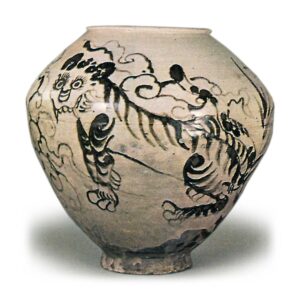
Iron sand is a material containing a large amount of iron oxide and is used for coloring and glazing. This red-sand material was called “Ishima” in Korea, and those painted with it were called “Ishima Shuki”. Egidarazu, Shino, and E-Seto are iron sand paintings and belong to the same lineage as Yi Dynasty iron sand. Iron rust painting in red iron sand on a black glaze is called “iron rust painting” and is considered to be good if crystals appear on the glaze. Iron sand is used as a glaze material to produce glazes such as tenmoku, sea squirt, persimmon, buckwheat, and candy.
However, what is usually called “iron sand glaze” refers to glazes in which iron sand is used directly to produce a gold-crystal pattern, or to ordinary iron black glazes that have turned reddish. The former was practiced in the Seto region in ancient times, using iron powder called kurohama to produce a gold-colored crystalline glaze, which was called kin-nagashi or kinki-glaze. It was called kin-nagashi or kinki-glaze. In later times, it was also called takatori glaze. The same type of glaze is called Setonagashi in the Izumo region. This allows us to imagine the route by which the glaze method was transmitted. There is also a Yi-chao jar with an inscription “Makuho iron sand” by Chojiro, which was hand-kneaded by the oxidation of iron.
The reddish-brown glaze is the most widely used since ancient times, and is found in Zi Ding and other wares from the Ding kilns of the Song dynasty (960-1279), and is called Kakitenmoku (persimmon tenmoku). The persimmon glaze of Seto and other red vases is an iron sand glaze. (Gashu, History of Japanese Ceramics in the Early Modern Period, and Meikoh of Korean Ceramics)



